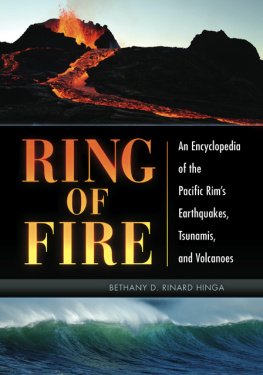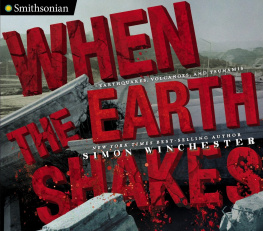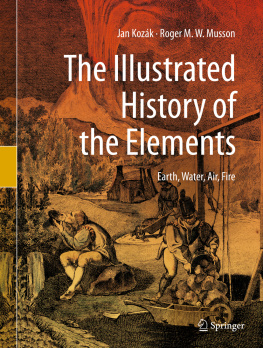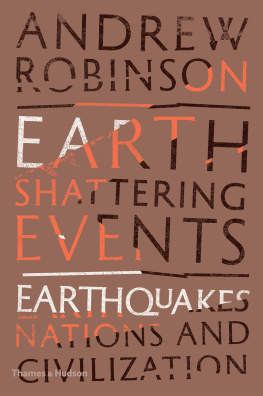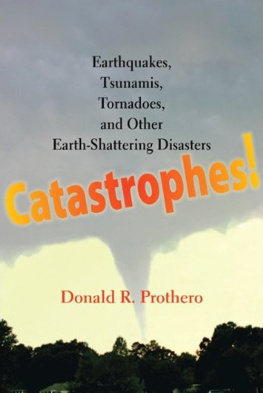

Copyright 2015 by ABC-CLIO, LLC
All rights reserved. No part of this publication may be reproduced, stored in a retrieval system, or transmitted, in any form or by any means, electronic, mechanical, photocopying, recording, or otherwise, except for the inclusion of brief quotations in a review, without prior permission in writing from the publisher.
The following entries in this volume were written by Angus M. Gunn: Chilean Earthquake and Tsunami (1960); Kobe Earthquake, Japan (1995); Mexico City Earthquake, Mexico (1985); Sanriku Earthquake and Tsunami, Japan (1896).
Library of Congress Cataloging-in-Publication Data
Rinard Hinga, Bethany D.
Ring of fire : an encyclopedia of the Pacific Rims earthquakes, tsunamis, and volcanoes / Bethany D. Rinard Hinga.
pages cm
Includes bibliographical references and index.
ISBN 978-1-61069-296-0 (alk. paper)ISBN 978-1-61069-297-7 (ebook) 1. EarthquakesPacific AreaEncyclopedias. 2. VolcanoesPacific AreaEncyclopedias. 3. TsunamisPacific AreaEncyclopedias. I. Title. II. Title: Encyclopedia of the Pacific Rims earthquakes, tsunamis, and volcanoes.
QE537.5.R56 2015
551.209182303dc23 2014037773
ISBN: 978-1-61069-296-0
EISBN: 978-1-61069-297-7
19 18 17 16 15 1 2 3 4 5
This book is also available on the World Wide Web as an eBook.
Visit www.abc-clio.com for details.
ABC-CLIO, LLC
130 Cremona Drive, P.O. Box 1911
Santa Barbara, California 93116-1911
This book is printed on acid-free paper 
Manufactured in the United States of America
Contents
The Encyclopedia
List of Entries
List of Entries by Earthquake,
Tsunami, and Volcano
Earthquake-Related Entries
Tsunami-Related Entries
Volcano-Related Entries
Preface
The Pacific Rim is one of the most geologically active regions of the planet. Here, it is possible to observe the raw power of planet Earth through unexpected and often violent events, such as volcanic eruptions, earthquakes, and tsunamis. This book examines the specific interactions of tectonic plates in and around the Pacific Ocean. The region of interest extends from the west coasts of North America and South America to the Aleutian Islands of Alaska. It extends from the Aleutian Islands southward through the Kamchatka Peninsula of Russia; through the Kuril Islands, Japan, and the Philippines; to Indonesia and southward to New Zealand. The Pacific Rim includes incredibly diverse geographic regions created by immense tectonic forces.
This encyclopedia explores the vast Pacific region of the earth from historical, geographical, and geological perspectives. All entries pertain to some aspect of Pacific Rim volcanic, earthquake, or tsunami activity or the study of such events. It is thoroughly cross-referenced, which enables readers to further explore a topic simply by following suggestions about which other related entries might be of interest or provide further clarification on a subject.
The scope of this book is quite broad, ranging from the configuration of and interaction between the tectonic plates that comprise the Pacific region to descriptions of specific disastrous eventsincluding features found on individual volcanoes. The book includes information about topics at both ends of this scale and from every point in between. I tried to tell important stories as was appropriate, rather than simply conveying facts. It has been my experience that often it is from the narrative that scholars learn most effectively.
I was approached in the spring of 2012 about writing this book. It has been an ever-present part of my life since that timethrough two career changes, one cross-country move, and one new child. Through the experience of writing I have had a chance to relive some of my youth and many of my travels, as well as to learn more about distant lands I have yet to visit. I have been fascinated by the natural world, and specifically by volcanoes, since I was a child. When Mount St. Helens erupted in 1980, I was eight years old and living on a farm in central Iowa. I had family members who lived near Mount St. Helens. They sent me newspaper articles and photos, and brought me volcanic ash when they came to visit. From that time onward, I became obsessed by all things volcanic.
I entered college as the rare studentone who knew exactly what I wanted to do with my life study volcanoes. I had some wonderful experiences as an undergraduate, when studying older volcanoes in Colorado and New Mexico. After graduation, I secured a coveted summer internship at the Hawaiian Volcano Observatory. Through the summer, I spent a great deal of time both in the laboratory and the field learning about Hawaiian volcanism by studying the ongoing eruption of the Kilauea volcano with my mentors, the first all-female Geology Group in the observatorys history. I was fortunate to reconnect with my friends at the Hawaiian Volcano Observatory when I began work on my dissertation a few years later. I worked with seismologist Dr. Paul Okubo, and used volcanic earthquakes within the western half of Kilauea to map its subsurface structure. To Dr. Okubo and the rest of the staff at the observatory who graciously assisted me in one major way or another as I learned the ins and outs of Hawaiian seismology and observatory databases, I will always be grateful.
I was fortunate to spend the first 17 years of my career in the classroom at Tarleton State University. I taught courses in geologyincluding natural disastersto a generation of students. Most of this book, however, was written while I was employed at the University of Nebraska at Kearney. I wish to thank Dr. Kenya Taylor for her personal example, showing that it is possibleand, in fact, enjoyableto engage in research even after leaving the classroom. Dr. Taylor encouraged me to keep my interests in geology alive as I moved from teaching in my academic field to an administrative role in higher education. This book serves as my bridge from one world to the other. I hope it serves as a bridge for you, as well, to an understanding of natural events that all too often turn into natural disasters.
Introduction
Geologists often speak of the earth as a dynamic planeta world that constantly is in a state of dramatic change. Across much of the earth, however, it is difficult to see direct evidence of these rapid changes because most geologic processes are achingly slow. Even in the best of circumstances, it takes hundreds to thousands of years for sediment to be buried and turned into rock. Rocks are weathered into sand, but the weathering process can take thousands or even millions of years. Mountains can rise from the plains, but this often takes tens of millions of years. Why then is Earth considered such a dynamic planet? The answer lies in the relentless movement of the earths tectonic plates.
The earths plates are in constant motion because of the circulation of the upper mantle beneath them. At places where plates come into contact with each other, the earth changes rapidly and dramatically. It is at these places that earthquakes disrupt peoples daily lives. It is at these places that volcanoes destroy landscapes, only to rebuild them in a new image. It is along shorelines with such plate contact that tsunamis can sweep in and carry away communities in a tragic few minutes. In very few places are these types of events seen more frequently than in the region called the Ring of Fire.
Next page
